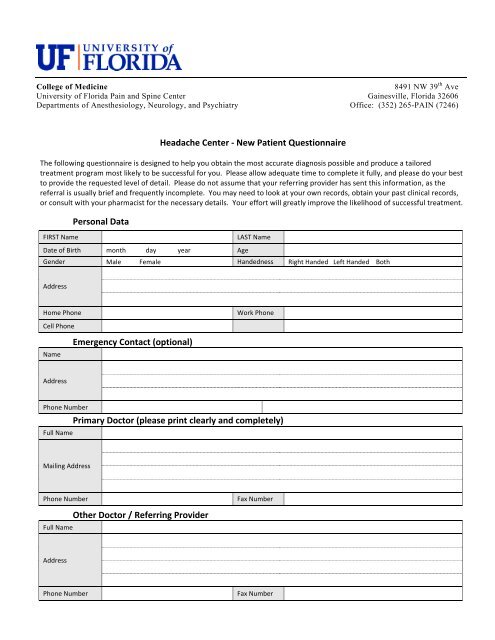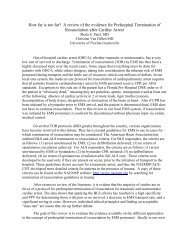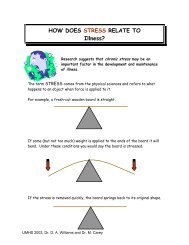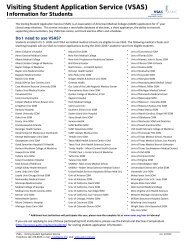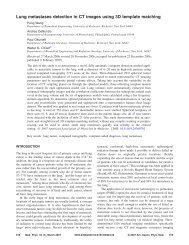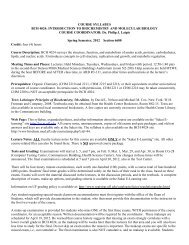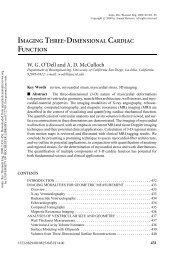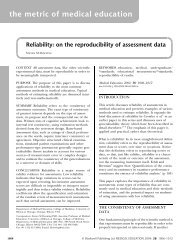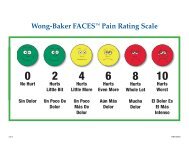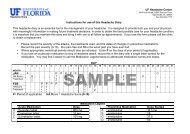Headache Intake Form - UF Pain Medicine / Management
Headache Intake Form - UF Pain Medicine / Management
Headache Intake Form - UF Pain Medicine / Management
- No tags were found...
You also want an ePaper? Increase the reach of your titles
YUMPU automatically turns print PDFs into web optimized ePapers that Google loves.
!REVIEW OF SYSTEMS Are you experiencing any NEW recent changes to your health, aside from in association with your headache or other known conditions? Please check (√) ALL that apply: Constitutional Medical Neuropsychiatric I Neuropsychiatric II Fever !Chills New onset of night sweats Unexplained weight gain !Unexplained weight loss New skin rash Excessive urination Nausea !Vomiting Diarrhea !Constipation Shortness of breath !Palpitations !Chest pain Loss of smell Loss of vision Difficulty chewing Difficulty swallowing Loss of hearing Loss of balance Loss of bladder control Convulsions Depression Anxiety Feelings of worthlessness Feelings like you might hurt yourself Flashbacks Hallucinations Change in menstrual pattern Joint swelling Loss of bowel control If you have checked any of the above, please provide details of occurrence: DIAGNOSTIC STUDIES Please provide dates and details of any studies, tests, or images that have been performed: Study Date Findings ! BRAIN MRI ! NECK MRI ! MRA/MRV ! Head CT ! Lumbar puncture ! Sleep Study! EEG!
MIDAS (Migraine Disability Assessment) About MIDAS: The MIDAS (migraine disability assessment) questionnaire is a tool to help you measure the impact your headaches have on your life over the last 3 months. The best way to this is by counting the numbers of days of your life which are affected by <strong>Headache</strong>s. You can do this for yourself as follows: INSTRUCTIONS: • Please complete Questions about ALL your headaches you have had over the last 3 months. • Write your answer in the box next to each question. • If a single headache affects more than one area of your life (e.g., work and family life) it is counted more than once. • Mark question as zero if you did not do the activity in the last three months. • For questions 1 and 2, work or school means paid work or education if you are a student at school or college. • For Questions 3 and 4, household work means activities such as housework, home repairs and maintenance, shopping as well as caring for children and relatives. 1. On how many days in the last 3 months did you miss work or school because of your headaches? 2. How many days in the last 3 months was your productivity at work or school reduced by half or more because of your headaches? (Do not include days you counted in question 1 where you missed work or school) 3. On how many days in the last 3 months did you not do household work because of your headaches? 4. How many days in the last 3 months was your productivity in household work reduced by half or more because of your headaches? (Do not include days you counted in question 3 where you did not do household work) 5. On how many days in the last 3 months did you miss family, social or leisure activities because of your headaches? days days days days days To score, add points for answers in each column Total: days MIDAS Score MIDAS Grade 0–5 I 6–10 II Definition Minimal or infrequent disability Mild or infrequent disability Recommendations MIDAS Grade I usually indicates low medical need. Simple, over-‐the-‐counter analgesics may be effective in the acute treatment of these patients. However, the impact of even a few lost days on the lifestyle of these patients should be assessed. Also, some patients with a MIDAS Grade I, such as those with infrequent, but severe migraine, may benefit from first-‐line treatment with specific migraine therapies (e.g. triptans). MIDAS Grade I patients who have failed to achieve effective relief with simple analgesics should also be considered for triptan therapy. MIDAS Grade II usually indicates moderate medical need. The patients may require an acute prescription medication. Some MIDAS Grade II patients may also qualify for first-‐line triptan medication if their headaches are severe. For example, a score of 10 could mean that a patient is missing ten days of school or paid work, so the headaches could be causing severe disruption in their lives. MIDAS Grade II patients should also qualify for first-‐line triptan medication if they have failed on simple analgesics. 11–20 III >21 IV Moderate disability Severe disability MIDAS Grade III/IV indicates a high medical need. These patients are experiencing significant disability and their migraine attacks are having a severe impact on their lives. Specific acute therapy, such as a triptan, is usually the most appropriate therapy for these patients, providing they are suitable recipients. Prophylactic treatment should also be considered. Please note that a very high MIDAS score could also indicate a high frequency of non-migraine headache, and these patients should be managed accordingly.
HIT-‐6 (HEADACHE IMPACT TEST) About HIT-‐6: The <strong>Headache</strong> Impact Test (HIT) is a tool used to measure the impact headaches have on your ability to function on the job, at school, at home and in social situations. Your score shows you the effect that headaches have on normal daily life and your ability to function. 1. When you have headaches, how often is the pain severe? !Never !Rarely !Sometimes !Very Often !Always 2. How often do headaches limit your ability to do usual daily activities including household work, work, school, or social activities? !Never !Rarely !Sometimes !Very Often !Always 3. When you have a headache, how often do you wish you could lie down? !Never !Rarely !Sometimes !Very Often !Always 4. In the past 4 weeks, how often have you felt too tired to do work or daily activities because of your headaches? !Never !Rarely !Sometimes !Very Often !Always 5. In the past 4 weeks, how often have you felt fed up or irritated because of your headaches? !Never !Rarely !Sometimes !Very Often !Always 6. In the past 4 weeks, how often did headaches limit your ability to concentrate on work or daily activities? !Never !Rarely !Sometimes !Very Often !Always COLUMN 1 (6 points each) COLUMN 2 (8 points each) COLUMN 3 (10 points each) COLUMN 4 (11 points each) COLUMN 5 (13 points each) To score, add points for answers in each column Total Score: If You Scored 60 or More Your headaches are having a very severe impact on your life. You may be experiencing disabling pain and other symptoms that are more severe than those of other headache sufferers. Don’t let your headaches stop you from enjoying the important things in your life, like family, work, school or social activities. If You Scored 56 – 59 If You Scored 50 – 55 If You Scored 49 or Less Your headaches are having a substantial impact on your life. As a result you may be experiencing severe pain and other symptoms, causing you to miss some time from family, work, school, or social activities. Your headaches seem to be having some impact on your life. Your headaches should not make you miss time from family, work, school, or social activities. Your headaches seem to be having little to no impact on your life at this time. We encourage you to take HIT-‐6 monthly to continue to track how your headaches affect your life. If Your Score on HIT-‐6 is 50 or Higher You should share the results with your doctor. <strong>Headache</strong>s that are disrupting your life could be migraine.


